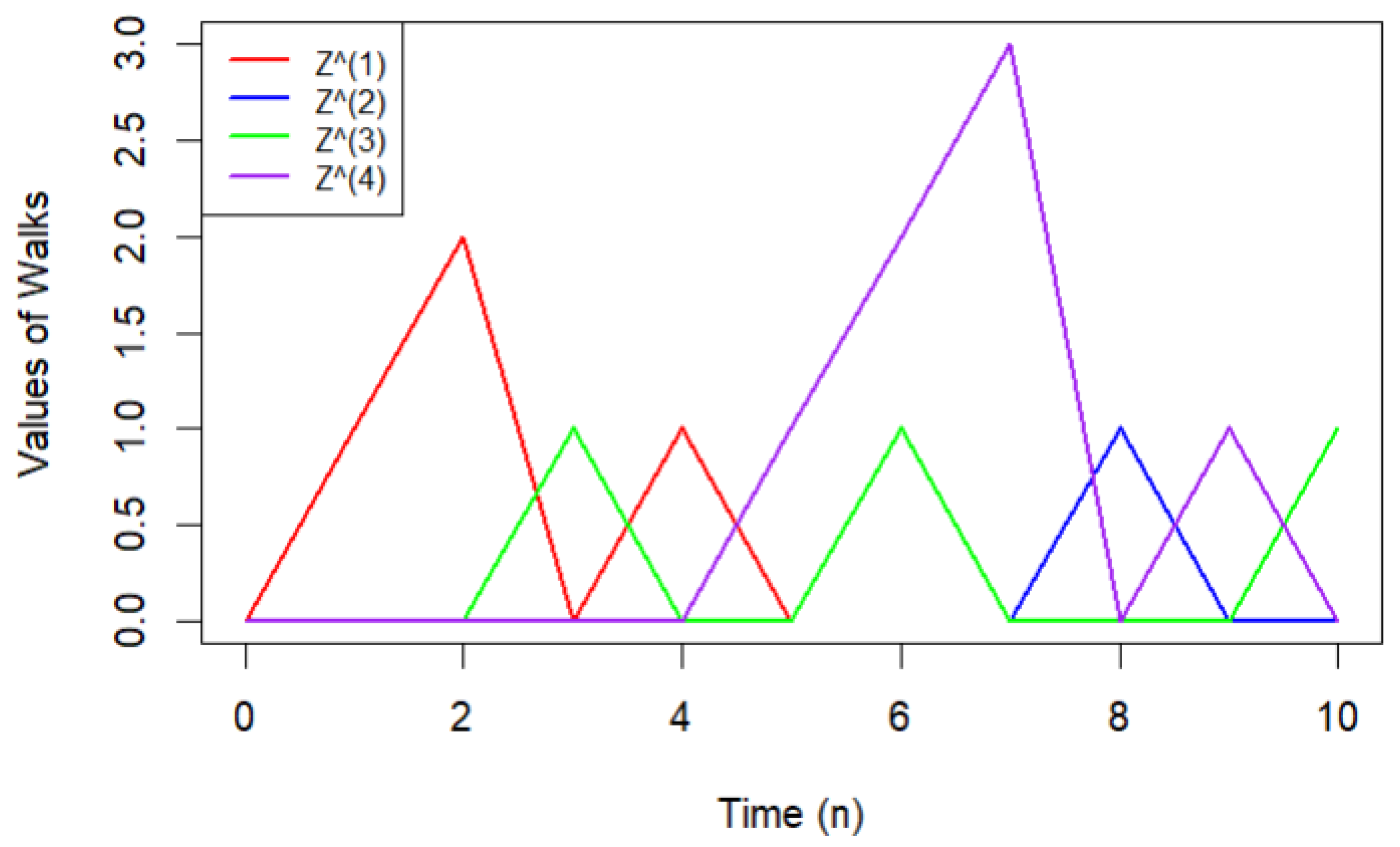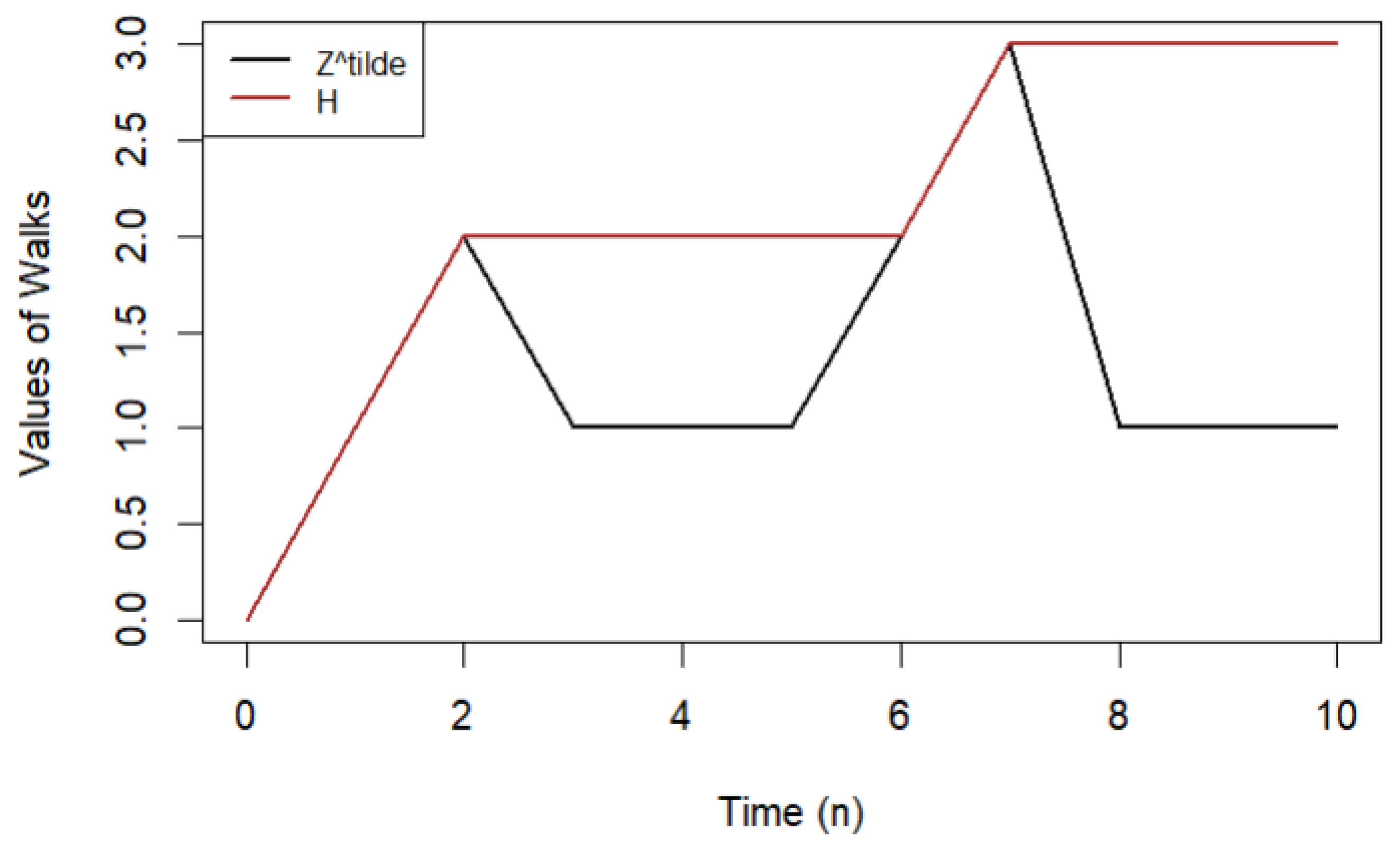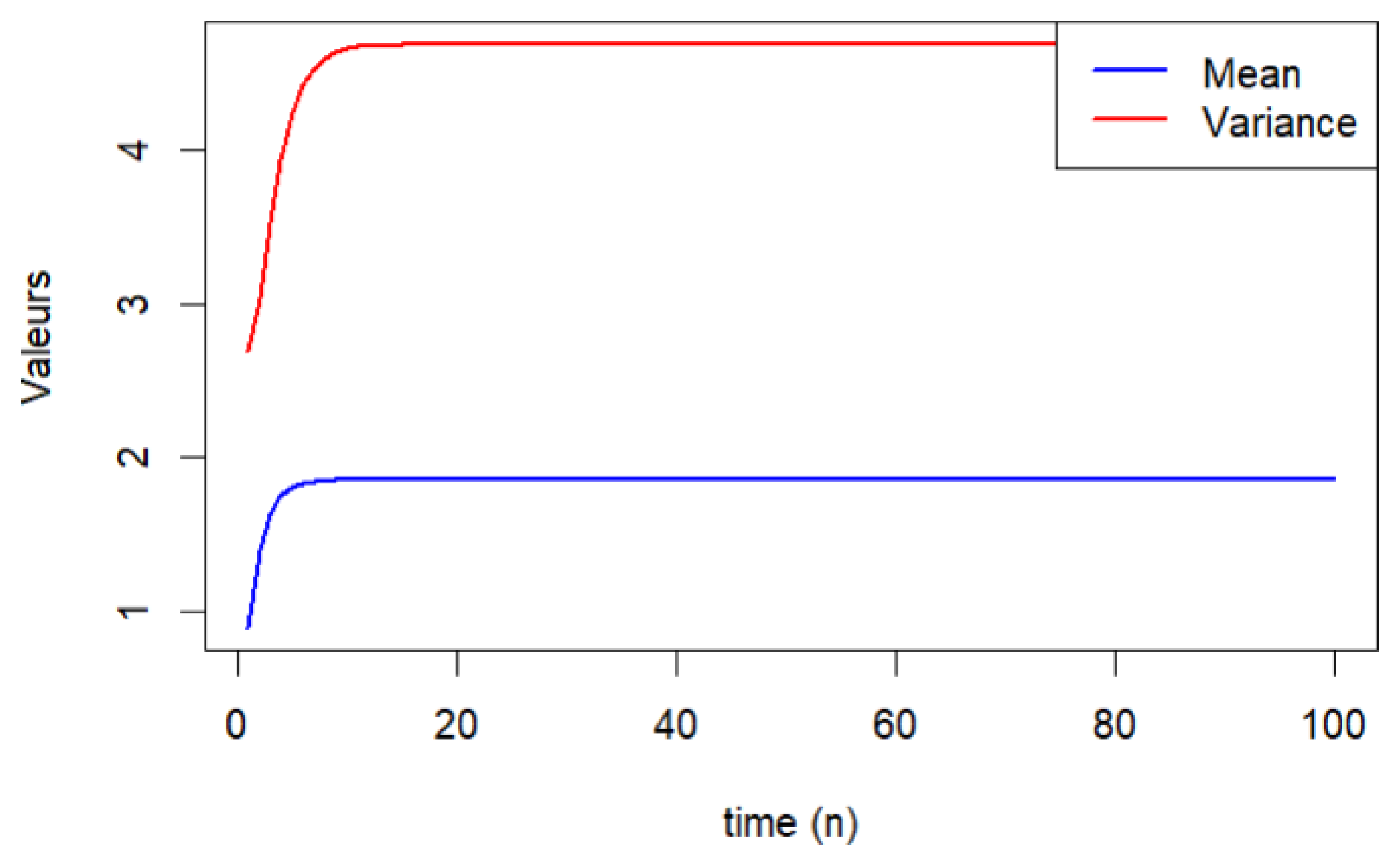Non-Uniformly Multidimensional Moran Random Walk with Resets
Abstract
1. Introduction
2. Presentation of the Model
- 1.
- We define the walk , called final altitude (maximum) of the walk , at time n by
- 2.
- Furthermore, we introduce the process , called height statistics, as the maximum of , that is, at time n


3. Main Result
- 1.
- Theorem 1 provides an explicit expression for the probability generating function (PGF) of the final altitude of the m-dimensional Moran walk. The PGF encodes all probabilistic information about , allowing computation of moments (mean, variance) and, in principle, the full distribution.
- 2.
- The Formula (4) can be interpreted as the sum of three contributions:
- corresponds to the scenario where all components increment together at each step, i.e., no resets occur.
- accounts for global resets with probability , producing a geometric-like contribution across all components.
- The summation term captures single-component increments and partial resets, reflecting the combined effects of individual growth probabilities and the collective increment .
- 3.
- 4.
- It captures both uniform and non-uniform increment probabilities, making it applicable to multi-component processes such as multi-strain epidemic models or gamete age dynamics.
- 1.
- In one dimension , the model (6) is equivalent to the following modelwith the probability generating function given by
- 2.
- In two dimensions , the model (6) is equivalent to the following modelwith the probability generating function given by:
- 3.
- In three dimensions , the model (6) is equivalent to the following modelwith the probability generating function given by:
- 1.
- Mean : The first term, , represents the contribution of the global reset events, which effectively reduce the growth of the maximum altitude across the m components. The summation term captures the cumulative effect of individual component increments and combined increments, weighted by .
- 2.
- Variance : The variance formula is more complex, reflecting the interplay between global resets and individual increments. The first two terms account for correlations introduced by global resets, while the summation over j captures the variance contribution of each component’s individual dynamics. The final two terms adjust for the square of the mean to ensure the correct computation of variance.
- 3.
- These formulas explicitly show how both the number of components m and the probabilities , influence the expected final altitude and its variability.
- 4.
- These explicit results allow quantitative analysis of multi-component stochastic systems, such as the expected maximum age of gametes, times between outbreaks in multi-strain epidemic models, or other processes modeled by high-dimensional Moran walks.
- 1.
- In one dimension ,
- 2.
- In two dimensions ,
4. Numerical Examples
- The mean for Case 1 rises from 0.9 to approximately 1.856 by and remains constant thereafter.
- Similarly, its variance stabilizes around the value of 4.678 by .
5. Recursive Equations
- 1.
- Initial Condition: The first case provides the base probability , which initializes the recursion and ensures that the probability distribution is properly defined at the starting state.
- 2.
- Single-component Increment: The second case describes the probability when exactly one component is nonzero and all other components are zero. It accounts for the contributions from all possible configurations of previous steps, captured by the sum over . This reflects the combinatorial structure of the Moran process in a single dimension while conditioning on the previous states.
- 3.
- General Increment: The third case covers the situation where multiple components may be positive. Here, the recursion uses , meaning that the probability of the current configuration depends linearly on the probability of the configuration at the previous step, with all components decreased by one. This highlights the memory structure of the process across steps.
- 1.
- Proposition 1 establishes a recursive relation for the sequence of multivariate polynomials , which plays a central role in characterizing the joint distribution of the multidimensional Moran random walk. Each polynomial is expressed in terms of the previous polynomial , highlighting the step-by-step evolution of the process.
- 2.
- The summation term captures the effect of incrementing each component individually. Here, ensures that only the j-th component is transformed while the others remain at 1, reflecting the non-uniform multidimensional dynamics.
- 3.
- The product term corresponds to simultaneous increments across all components, weighted by the probability p. This term accounts for correlated changes and ensures the polynomial fully captures multivariate interactions.
- 4.
- The base case initializes the recursion, providing a foundation for constructing higher-order polynomials systematically.
6. Distribution of the Random Walks
- 1.
- The theorem provides the explicit probability generating function for each component of the multidimensional Moran random walk. This function encapsulates the full distributional information of the process and serves as a powerful tool to derive moments and other probabilistic characteristics.
- 2.
- The Formula (14) gives a closed-form expression for any step n, making computations of the mean, variance, and higher moments straightforward.
- 3.
- Equation (15) characterizes the long-term behavior of the process and confirms that the distribution stabilizes as .
- 4.
- The limiting distribution depends on the parameter , which reflects both the individual component probabilities and the global interaction term . This highlights the interplay between individual and collective dynamics in the Moran walk.
7. Conclusions and Perspectives
- Generalization of reset mechanisms: How do the statistical properties of the multidimensional Moran walk change if resets follow more general distributions (e.g., non-geometric, state-dependent, or time-varying probabilities) rather than the uniform or fixed-probability resets considered here?
- Interaction between components: Can we extend the model to include dependencies or interactions between components, such as coupled increments or correlated reset events, and characterize their impact on the mean, variance, and extremal behavior?
- Continuous-time extensions: How would the results change if the model is formulated in continuous time, leading to a multidimensional Poisson or jump process analog of the Moran walk?
- Application to population dynamics: How can the m-dimensional Moran walk be applied to model multi-strain epidemics, gamete aging, or other population dynamics scenarios, and can the theoretical results inform control or intervention strategies?
- Limit distributions of extrema: Beyond the mean and variance, what are the precise limiting distributions of the maximum component (final altitude) in higher dimensions, and can extreme value theory provide further insights?
- Algorithmic and computational aspects: Can efficient simulation or approximation algorithms be developed for high-dimensional Moran walks, enabling practical evaluation of their statistical properties in large-scale applications?
Funding
Data Availability Statement
Conflicts of Interest
Appendix A
Appendix B
References
- Moran, P.A.P. Random processes in genetics. Math. Proc. Camb. Philos. Soc. 1958, 54, 6071. [Google Scholar] [CrossRef]
- Moran, P.A.P. The Statistical Processes of Evolutionary Theory; Oxford University Press: Oxford, UK, 1962. [Google Scholar]
- Itoh, H.; Mahmoud, H.M. Age statistics in the Moran population model. Stat. Probab. Lett. 2005, 74, 21–30. [Google Scholar] [CrossRef]
- Itoh, Y.; Mahmoud, H.M.; Takahashi, D. A stochastic model for solitons. Random Struct. Algorithms 2004, 24, 51–64. [Google Scholar] [CrossRef]
- Aguech, R.; Althagafi, A.; Banderier, C. Height of Walks with Resets and the Moran Model and The Discrete Gumbel Distribution. arXiv 2023, arXiv:2311.13124. [Google Scholar] [CrossRef]
- Banderier, C. Combinatoire analytique des chemins et des cartes. Ph.D. Thesis, Pierre and Marie Curie University, Paris, France, 2001. [Google Scholar]
- Banderier, C.; Flajolet, P. Basic analytic combinatorics of directed lattice paths. Theor. Comput. Sci. 2002, 281, 37–80. [Google Scholar] [CrossRef]
- Flajolet, P.; Sedgewick, R. Analytic Combinatorics; Cambridge University Press: Cambridge, UK, 2009. [Google Scholar]
- Althagafi, A.; Abdelkader, M. Two-Dimensional Moran Model. Symmetry 2023, 15, 1046. [Google Scholar] [CrossRef]
- Aguech, R.; Abdelkader, M. Two-Dimensional Moran Model: Final Altitude and Number of Resets. Mathematics 2023, 11, 3774. [Google Scholar] [CrossRef]
- Huillet, T. Random walk Green kernels in the neutral Moran modelconditioned on survivors at a random time to origin. Math. Popul. Stud. 2016, 23, 164–200. [Google Scholar] [CrossRef]
- Huillet, T.; Möhle, M. Duality and asymptotics for a class of nonneutral discrete Moran models. J. Appl. Probab. 2009, 46, 866–893. [Google Scholar] [CrossRef][Green Version]
- Abdelkader, M. Three-Dimensional Moran Walk with Resets. Symmetry 2024, 15, 1046. [Google Scholar] [CrossRef]

| n | Case 1 | Case 2 | Case 3 | |||
|---|---|---|---|---|---|---|
| 1 | 0.900000 | 2.690000 | 0.900000 | 3.890000 | 0.900000 | 4.690000 |
| 2 | 1.395000 | 3.038975 | 1.605800 | 4.238806 | 1.685000 | 5.015775 |
| 3 | 1.638000 | 3.516956 | 2.122610 | 4.895977 | 2.354750 | 5.658902 |
| 4 | 1.753312 | 3.933083 | 2.486251 | 5.765493 | 2.916962 | 6.630567 |
| 5 | 1.807627 | 4.228505 | 2.735767 | 6.708160 | 3.383112 | 7.889136 |
| 6 | 1.833267 | 4.417186 | 2.904155 | 7.610732 | 3.765915 | 9.363300 |
| 7 | 1.845434 | 4.530598 | 3.016520 | 8.406204 | 4.077889 | 10.971901 |
| 8 | 1.851241 | 4.596246 | 3.090926 | 9.067864 | 4.330591 | 12.637591 |
| 9 | 1.854029 | 4.633306 | 3.139938 | 9.595678 | 4.534271 | 14.294555 |
| 10 | 1.855373 | 4.653863 | 3.172109 | 10.003865 | 4.697777 | 15.891675 |
| 15 | 1.856608 | 4.677199 | 3.225700 | 10.916101 | 5.134570 | 22.126498 |
| 20 | 1.856642 | 4.678202 | 3.232113 | 11.089041 | 5.271913 | 25.378529 |
| 25 | 1.856643 | 4.678242 | 3.232894 | 11.117922 | 5.314332 | 26.799313 |
| 30 | 1.856643 | 4.678243 | 3.232991 | 11.122500 | 5.327415 | 27.367648 |
| 35 | 1.856643 | 4.678243 | 3.233004 | 11.123207 | 5.331474 | 27.584513 |
| 40 | 1.856643 | 4.678243 | 3.233005 | 11.123314 | 5.332744 | 27.665079 |
| 45 | 1.856643 | 4.678243 | 3.233005 | 11.123331 | 5.333145 | 27.694527 |
| 50 | 1.856643 | 4.678243 | 3.233005 | 11.123333 | 5.333273 | 27.705178 |
| 100 | 1.856643 | 4.678243 | 3.233005 | 11.123333 | 5.333333 | 27.711111 |
| 500 | 1.856643 | 4.678243 | 3.233005 | 11.123333 | 5.333333 | 27.711111 |
| 1000 | 1.856643 | 4.678243 | 3.233005 | 11.123333 | 5.333333 | 27.711111 |
Disclaimer/Publisher’s Note: The statements, opinions and data contained in all publications are solely those of the individual author(s) and contributor(s) and not of MDPI and/or the editor(s). MDPI and/or the editor(s) disclaim responsibility for any injury to people or property resulting from any ideas, methods, instructions or products referred to in the content. |
© 2025 by the author. Licensee MDPI, Basel, Switzerland. This article is an open access article distributed under the terms and conditions of the Creative Commons Attribution (CC BY) license (https://creativecommons.org/licenses/by/4.0/).
Share and Cite
Abdelkader, M. Non-Uniformly Multidimensional Moran Random Walk with Resets. Axioms 2025, 14, 756. https://doi.org/10.3390/axioms14100756
Abdelkader M. Non-Uniformly Multidimensional Moran Random Walk with Resets. Axioms. 2025; 14(10):756. https://doi.org/10.3390/axioms14100756
Chicago/Turabian StyleAbdelkader, Mohamed. 2025. "Non-Uniformly Multidimensional Moran Random Walk with Resets" Axioms 14, no. 10: 756. https://doi.org/10.3390/axioms14100756
APA StyleAbdelkader, M. (2025). Non-Uniformly Multidimensional Moran Random Walk with Resets. Axioms, 14(10), 756. https://doi.org/10.3390/axioms14100756






